Finance for Managers Report: Financial Analysis and Recommendations
VerifiedAdded on 2020/06/06
|14
|3403
|193
Report
AI Summary
This report, prepared for a Finance for Managers course, delves into crucial aspects of financial management within a business context. It begins by outlining the objectives and needs of financial records, detailing methods of recording financial data, and evaluating the legal and business requirements of financial reporting. The report then analyzes the effectiveness of stakeholders and compares management accounting with financial accounting. Budgetary control processes, including planning and forecasting, are examined, along with various costing techniques such as fixed, variable, and marginal costing. The core of the report involves the computation and interpretation of variances, covering material, labor, and overhead costs, along with sales variances. Finally, the report explores working capital components, their management, and the importance of values in financial decision-making, concluding with recommendations for enhancing business profitability. The report also includes an operating statement and detailed variance analysis to assess the company's financial performance.
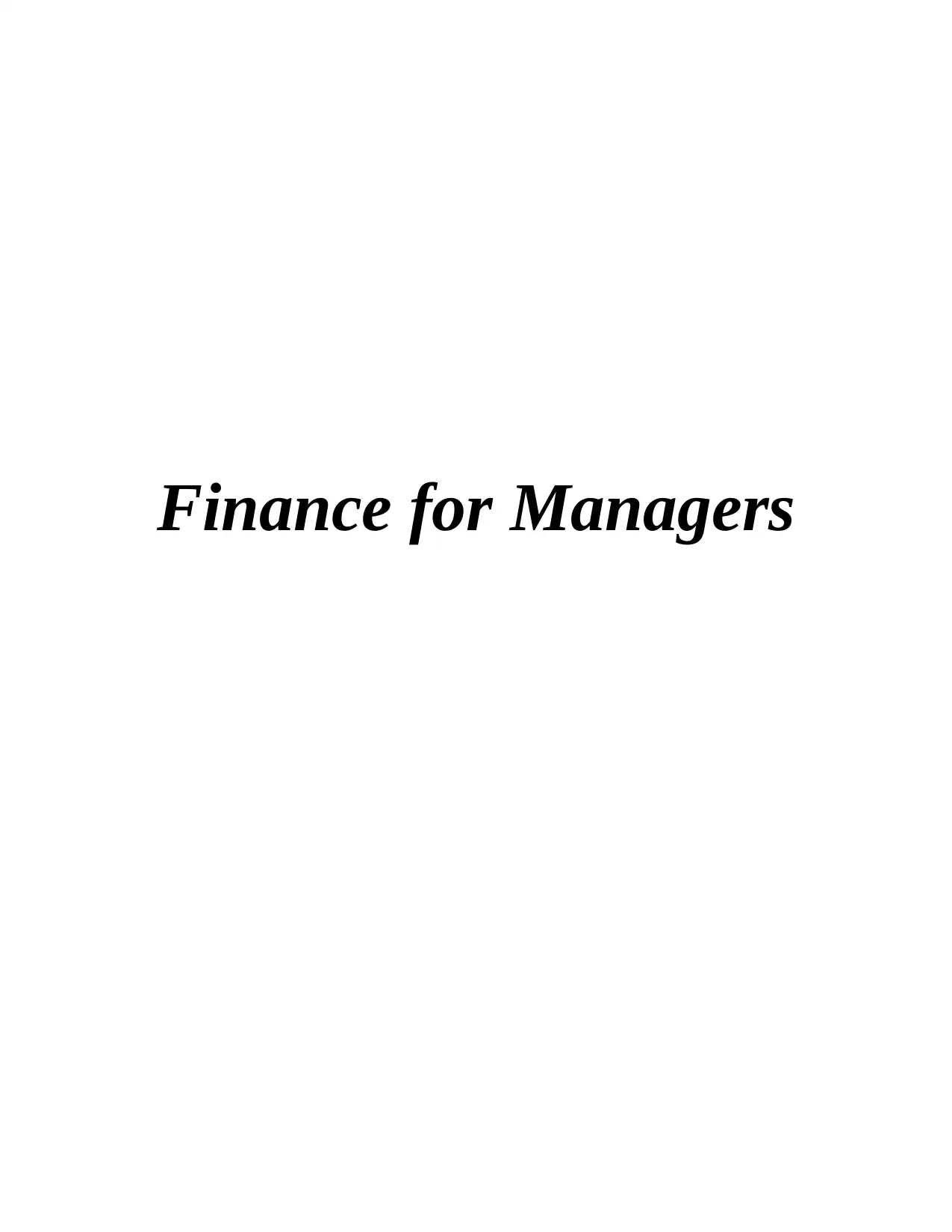
Finance for Managers
Paraphrase This Document
Need a fresh take? Get an instant paraphrase of this document with our AI Paraphraser
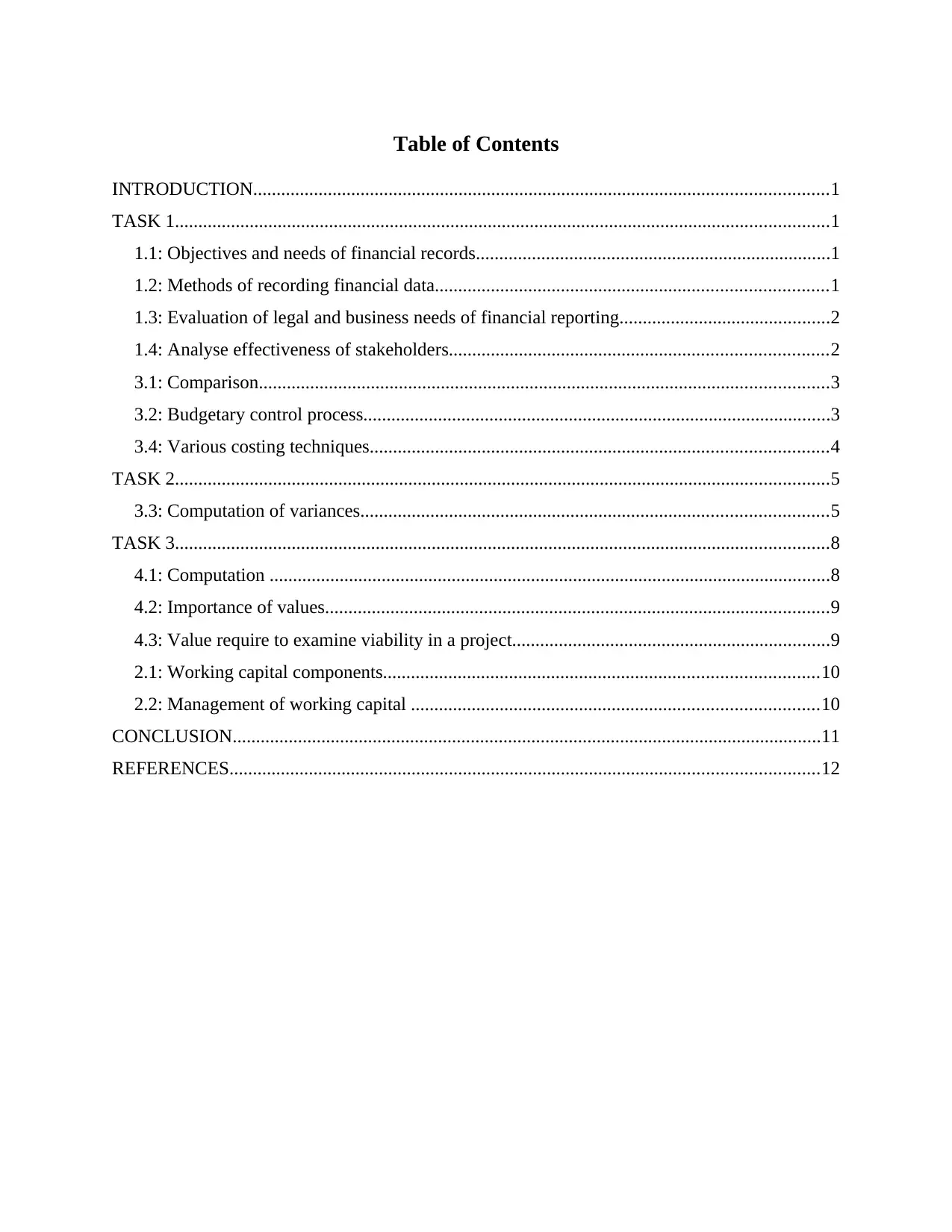
Table of Contents
INTRODUCTION...........................................................................................................................1
TASK 1............................................................................................................................................1
1.1: Objectives and needs of financial records............................................................................1
1.2: Methods of recording financial data....................................................................................1
1.3: Evaluation of legal and business needs of financial reporting.............................................2
1.4: Analyse effectiveness of stakeholders.................................................................................2
3.1: Comparison..........................................................................................................................3
3.2: Budgetary control process....................................................................................................3
3.4: Various costing techniques..................................................................................................4
TASK 2............................................................................................................................................5
3.3: Computation of variances....................................................................................................5
TASK 3............................................................................................................................................8
4.1: Computation ........................................................................................................................8
4.2: Importance of values............................................................................................................9
4.3: Value require to examine viability in a project....................................................................9
2.1: Working capital components.............................................................................................10
2.2: Management of working capital .......................................................................................10
CONCLUSION..............................................................................................................................11
REFERENCES..............................................................................................................................12
INTRODUCTION...........................................................................................................................1
TASK 1............................................................................................................................................1
1.1: Objectives and needs of financial records............................................................................1
1.2: Methods of recording financial data....................................................................................1
1.3: Evaluation of legal and business needs of financial reporting.............................................2
1.4: Analyse effectiveness of stakeholders.................................................................................2
3.1: Comparison..........................................................................................................................3
3.2: Budgetary control process....................................................................................................3
3.4: Various costing techniques..................................................................................................4
TASK 2............................................................................................................................................5
3.3: Computation of variances....................................................................................................5
TASK 3............................................................................................................................................8
4.1: Computation ........................................................................................................................8
4.2: Importance of values............................................................................................................9
4.3: Value require to examine viability in a project....................................................................9
2.1: Working capital components.............................................................................................10
2.2: Management of working capital .......................................................................................10
CONCLUSION..............................................................................................................................11
REFERENCES..............................................................................................................................12
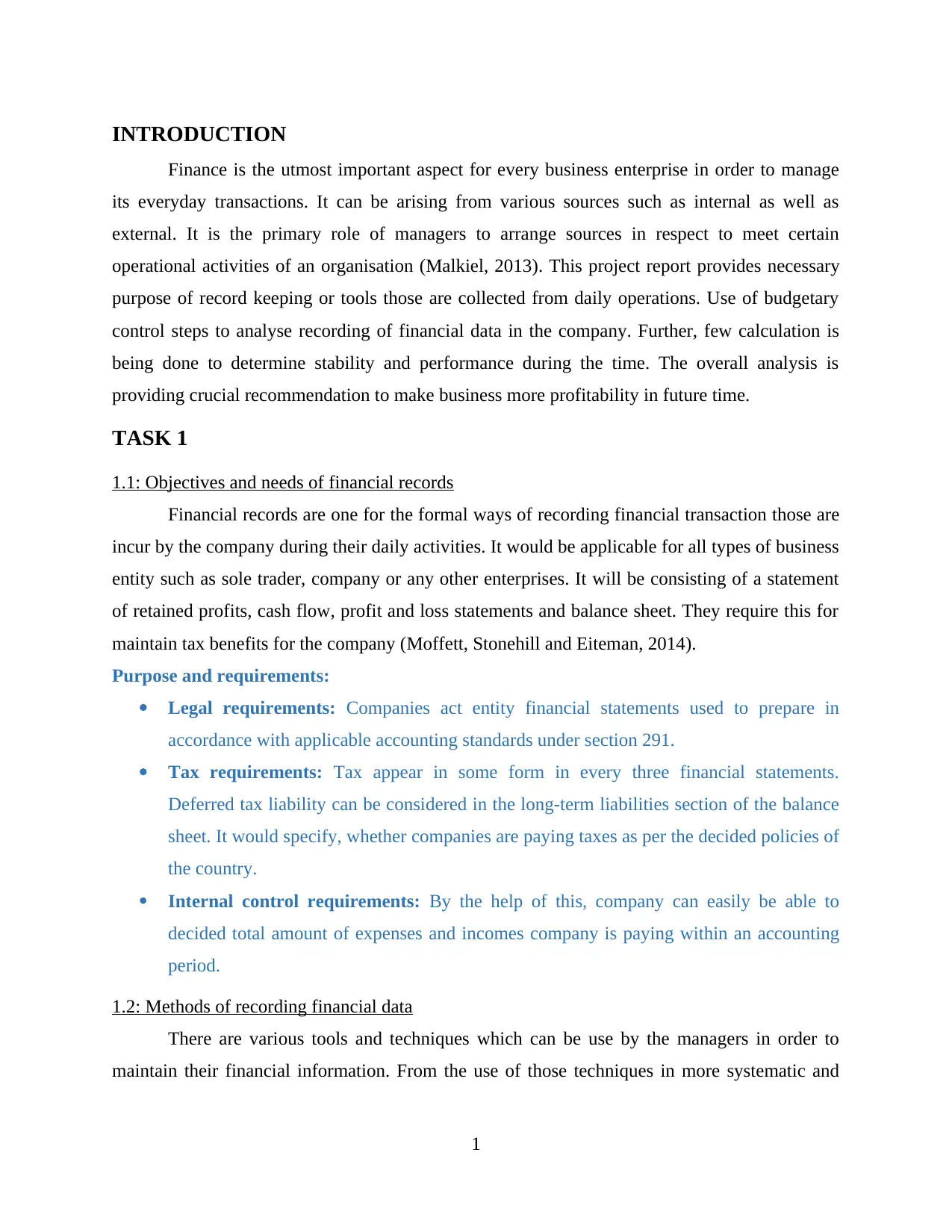
INTRODUCTION
Finance is the utmost important aspect for every business enterprise in order to manage
its everyday transactions. It can be arising from various sources such as internal as well as
external. It is the primary role of managers to arrange sources in respect to meet certain
operational activities of an organisation (Malkiel, 2013). This project report provides necessary
purpose of record keeping or tools those are collected from daily operations. Use of budgetary
control steps to analyse recording of financial data in the company. Further, few calculation is
being done to determine stability and performance during the time. The overall analysis is
providing crucial recommendation to make business more profitability in future time.
TASK 1
1.1: Objectives and needs of financial records
Financial records are one for the formal ways of recording financial transaction those are
incur by the company during their daily activities. It would be applicable for all types of business
entity such as sole trader, company or any other enterprises. It will be consisting of a statement
of retained profits, cash flow, profit and loss statements and balance sheet. They require this for
maintain tax benefits for the company (Moffett, Stonehill and Eiteman, 2014).
Purpose and requirements:
Legal requirements: Companies act entity financial statements used to prepare in
accordance with applicable accounting standards under section 291.
Tax requirements: Tax appear in some form in every three financial statements.
Deferred tax liability can be considered in the long-term liabilities section of the balance
sheet. It would specify, whether companies are paying taxes as per the decided policies of
the country.
Internal control requirements: By the help of this, company can easily be able to
decided total amount of expenses and incomes company is paying within an accounting
period.
1.2: Methods of recording financial data
There are various tools and techniques which can be use by the managers in order to
maintain their financial information. From the use of those techniques in more systematic and
1
Finance is the utmost important aspect for every business enterprise in order to manage
its everyday transactions. It can be arising from various sources such as internal as well as
external. It is the primary role of managers to arrange sources in respect to meet certain
operational activities of an organisation (Malkiel, 2013). This project report provides necessary
purpose of record keeping or tools those are collected from daily operations. Use of budgetary
control steps to analyse recording of financial data in the company. Further, few calculation is
being done to determine stability and performance during the time. The overall analysis is
providing crucial recommendation to make business more profitability in future time.
TASK 1
1.1: Objectives and needs of financial records
Financial records are one for the formal ways of recording financial transaction those are
incur by the company during their daily activities. It would be applicable for all types of business
entity such as sole trader, company or any other enterprises. It will be consisting of a statement
of retained profits, cash flow, profit and loss statements and balance sheet. They require this for
maintain tax benefits for the company (Moffett, Stonehill and Eiteman, 2014).
Purpose and requirements:
Legal requirements: Companies act entity financial statements used to prepare in
accordance with applicable accounting standards under section 291.
Tax requirements: Tax appear in some form in every three financial statements.
Deferred tax liability can be considered in the long-term liabilities section of the balance
sheet. It would specify, whether companies are paying taxes as per the decided policies of
the country.
Internal control requirements: By the help of this, company can easily be able to
decided total amount of expenses and incomes company is paying within an accounting
period.
1.2: Methods of recording financial data
There are various tools and techniques which can be use by the managers in order to
maintain their financial information. From the use of those techniques in more systematic and
1
⊘ This is a preview!⊘
Do you want full access?
Subscribe today to unlock all pages.

Trusted by 1+ million students worldwide
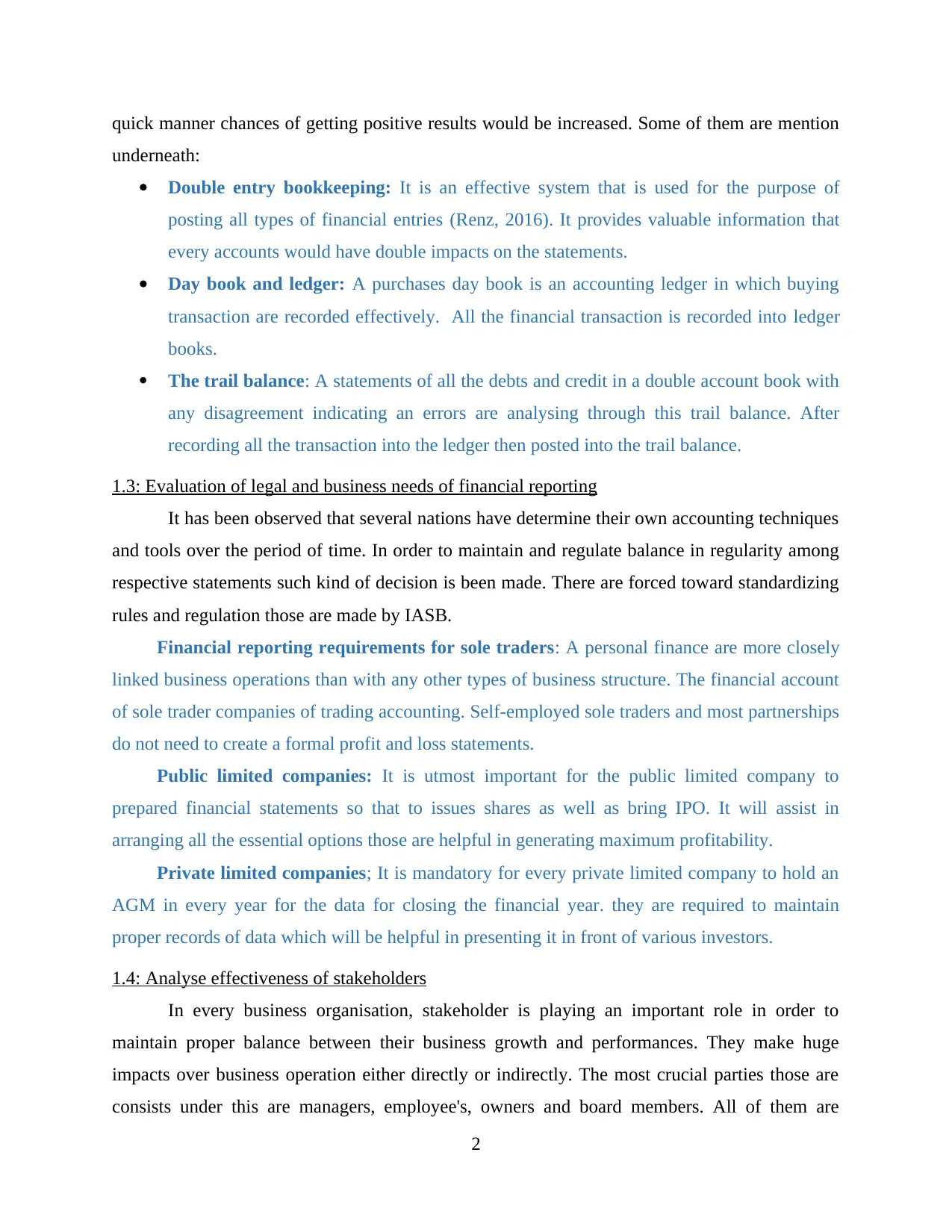
quick manner chances of getting positive results would be increased. Some of them are mention
underneath:
Double entry bookkeeping: It is an effective system that is used for the purpose of
posting all types of financial entries (Renz, 2016). It provides valuable information that
every accounts would have double impacts on the statements.
Day book and ledger: A purchases day book is an accounting ledger in which buying
transaction are recorded effectively. All the financial transaction is recorded into ledger
books.
The trail balance: A statements of all the debts and credit in a double account book with
any disagreement indicating an errors are analysing through this trail balance. After
recording all the transaction into the ledger then posted into the trail balance.
1.3: Evaluation of legal and business needs of financial reporting
It has been observed that several nations have determine their own accounting techniques
and tools over the period of time. In order to maintain and regulate balance in regularity among
respective statements such kind of decision is been made. There are forced toward standardizing
rules and regulation those are made by IASB.
Financial reporting requirements for sole traders: A personal finance are more closely
linked business operations than with any other types of business structure. The financial account
of sole trader companies of trading accounting. Self-employed sole traders and most partnerships
do not need to create a formal profit and loss statements.
Public limited companies: It is utmost important for the public limited company to
prepared financial statements so that to issues shares as well as bring IPO. It will assist in
arranging all the essential options those are helpful in generating maximum profitability.
Private limited companies; It is mandatory for every private limited company to hold an
AGM in every year for the data for closing the financial year. they are required to maintain
proper records of data which will be helpful in presenting it in front of various investors.
1.4: Analyse effectiveness of stakeholders
In every business organisation, stakeholder is playing an important role in order to
maintain proper balance between their business growth and performances. They make huge
impacts over business operation either directly or indirectly. The most crucial parties those are
consists under this are managers, employee's, owners and board members. All of them are
2
underneath:
Double entry bookkeeping: It is an effective system that is used for the purpose of
posting all types of financial entries (Renz, 2016). It provides valuable information that
every accounts would have double impacts on the statements.
Day book and ledger: A purchases day book is an accounting ledger in which buying
transaction are recorded effectively. All the financial transaction is recorded into ledger
books.
The trail balance: A statements of all the debts and credit in a double account book with
any disagreement indicating an errors are analysing through this trail balance. After
recording all the transaction into the ledger then posted into the trail balance.
1.3: Evaluation of legal and business needs of financial reporting
It has been observed that several nations have determine their own accounting techniques
and tools over the period of time. In order to maintain and regulate balance in regularity among
respective statements such kind of decision is been made. There are forced toward standardizing
rules and regulation those are made by IASB.
Financial reporting requirements for sole traders: A personal finance are more closely
linked business operations than with any other types of business structure. The financial account
of sole trader companies of trading accounting. Self-employed sole traders and most partnerships
do not need to create a formal profit and loss statements.
Public limited companies: It is utmost important for the public limited company to
prepared financial statements so that to issues shares as well as bring IPO. It will assist in
arranging all the essential options those are helpful in generating maximum profitability.
Private limited companies; It is mandatory for every private limited company to hold an
AGM in every year for the data for closing the financial year. they are required to maintain
proper records of data which will be helpful in presenting it in front of various investors.
1.4: Analyse effectiveness of stakeholders
In every business organisation, stakeholder is playing an important role in order to
maintain proper balance between their business growth and performances. They make huge
impacts over business operation either directly or indirectly. The most crucial parties those are
consists under this are managers, employee's, owners and board members. All of them are
2
Paraphrase This Document
Need a fresh take? Get an instant paraphrase of this document with our AI Paraphraser
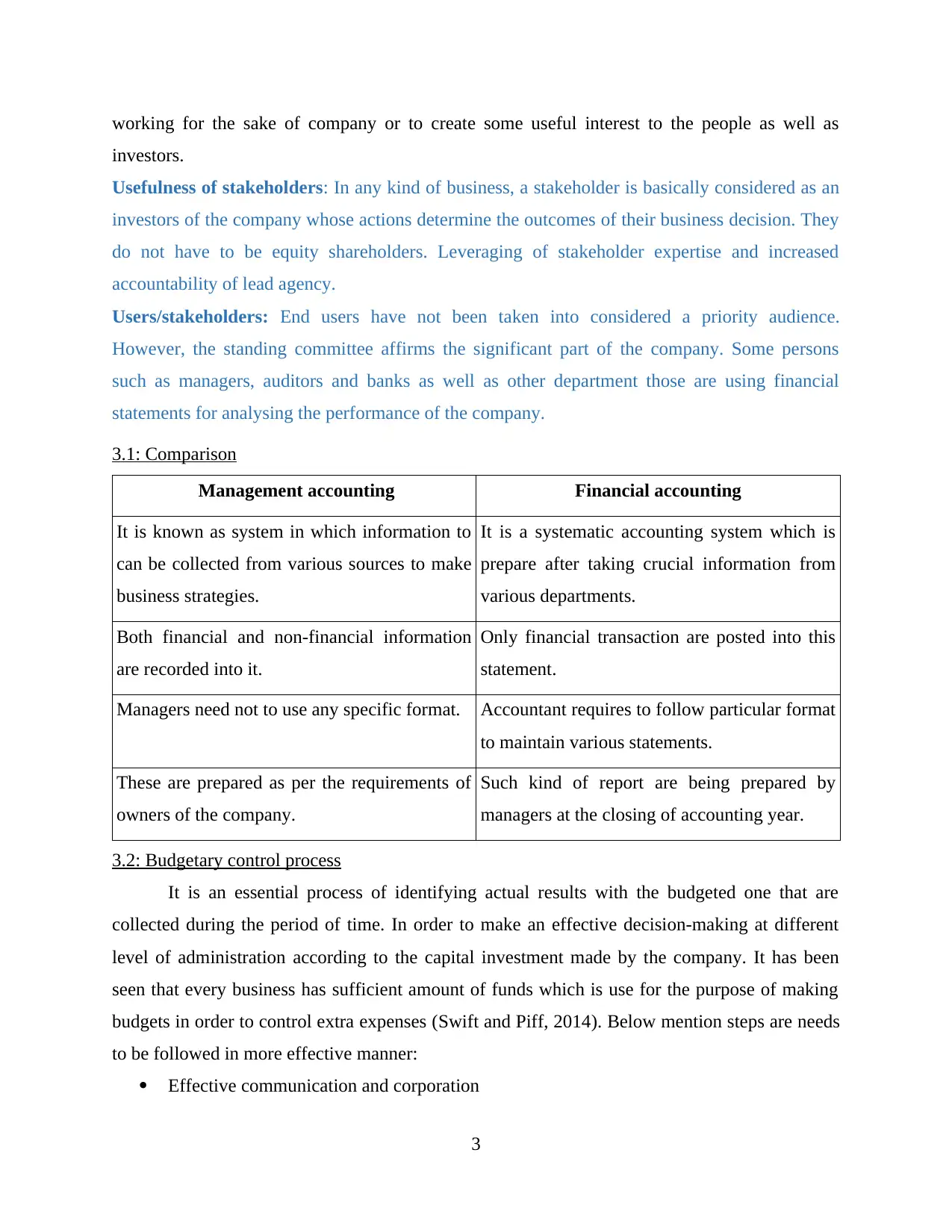
working for the sake of company or to create some useful interest to the people as well as
investors.
Usefulness of stakeholders: In any kind of business, a stakeholder is basically considered as an
investors of the company whose actions determine the outcomes of their business decision. They
do not have to be equity shareholders. Leveraging of stakeholder expertise and increased
accountability of lead agency.
Users/stakeholders: End users have not been taken into considered a priority audience.
However, the standing committee affirms the significant part of the company. Some persons
such as managers, auditors and banks as well as other department those are using financial
statements for analysing the performance of the company.
3.1: Comparison
Management accounting Financial accounting
It is known as system in which information to
can be collected from various sources to make
business strategies.
It is a systematic accounting system which is
prepare after taking crucial information from
various departments.
Both financial and non-financial information
are recorded into it.
Only financial transaction are posted into this
statement.
Managers need not to use any specific format. Accountant requires to follow particular format
to maintain various statements.
These are prepared as per the requirements of
owners of the company.
Such kind of report are being prepared by
managers at the closing of accounting year.
3.2: Budgetary control process
It is an essential process of identifying actual results with the budgeted one that are
collected during the period of time. In order to make an effective decision-making at different
level of administration according to the capital investment made by the company. It has been
seen that every business has sufficient amount of funds which is use for the purpose of making
budgets in order to control extra expenses (Swift and Piff, 2014). Below mention steps are needs
to be followed in more effective manner:
Effective communication and corporation
3
investors.
Usefulness of stakeholders: In any kind of business, a stakeholder is basically considered as an
investors of the company whose actions determine the outcomes of their business decision. They
do not have to be equity shareholders. Leveraging of stakeholder expertise and increased
accountability of lead agency.
Users/stakeholders: End users have not been taken into considered a priority audience.
However, the standing committee affirms the significant part of the company. Some persons
such as managers, auditors and banks as well as other department those are using financial
statements for analysing the performance of the company.
3.1: Comparison
Management accounting Financial accounting
It is known as system in which information to
can be collected from various sources to make
business strategies.
It is a systematic accounting system which is
prepare after taking crucial information from
various departments.
Both financial and non-financial information
are recorded into it.
Only financial transaction are posted into this
statement.
Managers need not to use any specific format. Accountant requires to follow particular format
to maintain various statements.
These are prepared as per the requirements of
owners of the company.
Such kind of report are being prepared by
managers at the closing of accounting year.
3.2: Budgetary control process
It is an essential process of identifying actual results with the budgeted one that are
collected during the period of time. In order to make an effective decision-making at different
level of administration according to the capital investment made by the company. It has been
seen that every business has sufficient amount of funds which is use for the purpose of making
budgets in order to control extra expenses (Swift and Piff, 2014). Below mention steps are needs
to be followed in more effective manner:
Effective communication and corporation
3
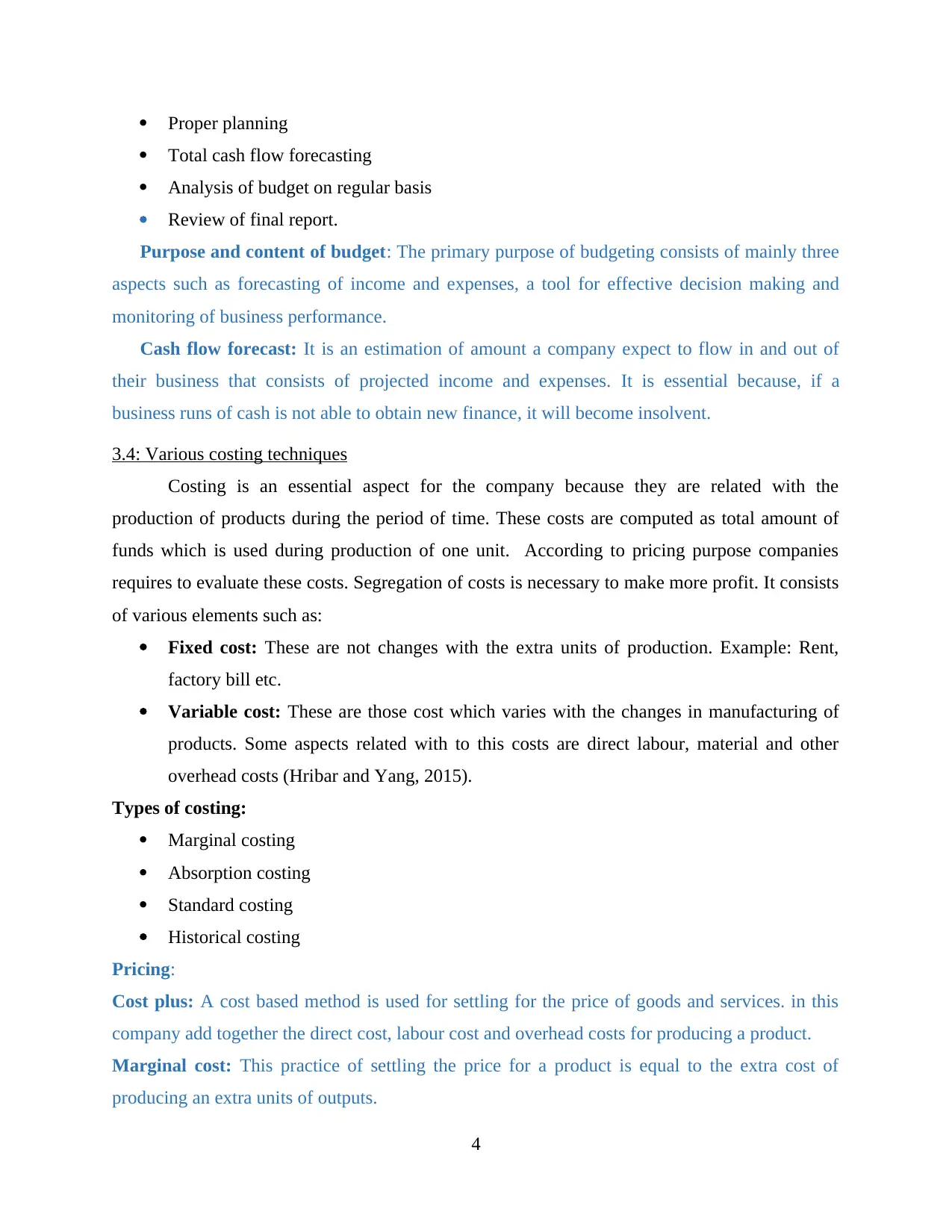
Proper planning
Total cash flow forecasting
Analysis of budget on regular basis
Review of final report.
Purpose and content of budget: The primary purpose of budgeting consists of mainly three
aspects such as forecasting of income and expenses, a tool for effective decision making and
monitoring of business performance.
Cash flow forecast: It is an estimation of amount a company expect to flow in and out of
their business that consists of projected income and expenses. It is essential because, if a
business runs of cash is not able to obtain new finance, it will become insolvent.
3.4: Various costing techniques
Costing is an essential aspect for the company because they are related with the
production of products during the period of time. These costs are computed as total amount of
funds which is used during production of one unit. According to pricing purpose companies
requires to evaluate these costs. Segregation of costs is necessary to make more profit. It consists
of various elements such as:
Fixed cost: These are not changes with the extra units of production. Example: Rent,
factory bill etc.
Variable cost: These are those cost which varies with the changes in manufacturing of
products. Some aspects related with to this costs are direct labour, material and other
overhead costs (Hribar and Yang, 2015).
Types of costing:
Marginal costing
Absorption costing
Standard costing
Historical costing
Pricing:
Cost plus: A cost based method is used for settling for the price of goods and services. in this
company add together the direct cost, labour cost and overhead costs for producing a product.
Marginal cost: This practice of settling the price for a product is equal to the extra cost of
producing an extra units of outputs.
4
Total cash flow forecasting
Analysis of budget on regular basis
Review of final report.
Purpose and content of budget: The primary purpose of budgeting consists of mainly three
aspects such as forecasting of income and expenses, a tool for effective decision making and
monitoring of business performance.
Cash flow forecast: It is an estimation of amount a company expect to flow in and out of
their business that consists of projected income and expenses. It is essential because, if a
business runs of cash is not able to obtain new finance, it will become insolvent.
3.4: Various costing techniques
Costing is an essential aspect for the company because they are related with the
production of products during the period of time. These costs are computed as total amount of
funds which is used during production of one unit. According to pricing purpose companies
requires to evaluate these costs. Segregation of costs is necessary to make more profit. It consists
of various elements such as:
Fixed cost: These are not changes with the extra units of production. Example: Rent,
factory bill etc.
Variable cost: These are those cost which varies with the changes in manufacturing of
products. Some aspects related with to this costs are direct labour, material and other
overhead costs (Hribar and Yang, 2015).
Types of costing:
Marginal costing
Absorption costing
Standard costing
Historical costing
Pricing:
Cost plus: A cost based method is used for settling for the price of goods and services. in this
company add together the direct cost, labour cost and overhead costs for producing a product.
Marginal cost: This practice of settling the price for a product is equal to the extra cost of
producing an extra units of outputs.
4
⊘ This is a preview!⊘
Do you want full access?
Subscribe today to unlock all pages.

Trusted by 1+ million students worldwide
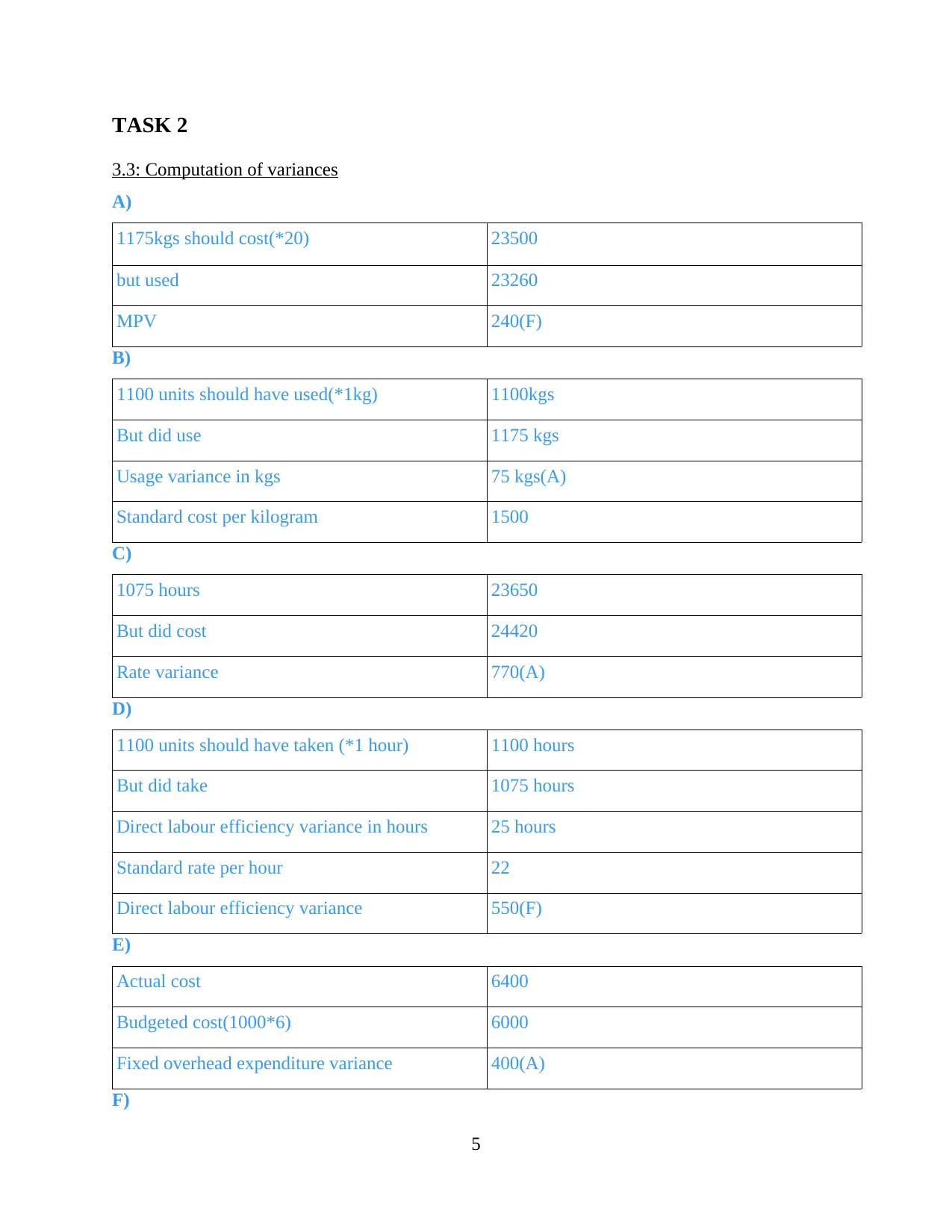
TASK 2
3.3: Computation of variances
A)
1175kgs should cost(*20) 23500
but used 23260
MPV 240(F)
B)
1100 units should have used(*1kg) 1100kgs
But did use 1175 kgs
Usage variance in kgs 75 kgs(A)
Standard cost per kilogram 1500
C)
1075 hours 23650
But did cost 24420
Rate variance 770(A)
D)
1100 units should have taken (*1 hour) 1100 hours
But did take 1075 hours
Direct labour efficiency variance in hours 25 hours
Standard rate per hour 22
Direct labour efficiency variance 550(F)
E)
Actual cost 6400
Budgeted cost(1000*6) 6000
Fixed overhead expenditure variance 400(A)
F)
5
3.3: Computation of variances
A)
1175kgs should cost(*20) 23500
but used 23260
MPV 240(F)
B)
1100 units should have used(*1kg) 1100kgs
But did use 1175 kgs
Usage variance in kgs 75 kgs(A)
Standard cost per kilogram 1500
C)
1075 hours 23650
But did cost 24420
Rate variance 770(A)
D)
1100 units should have taken (*1 hour) 1100 hours
But did take 1075 hours
Direct labour efficiency variance in hours 25 hours
Standard rate per hour 22
Direct labour efficiency variance 550(F)
E)
Actual cost 6400
Budgeted cost(1000*6) 6000
Fixed overhead expenditure variance 400(A)
F)
5
Paraphrase This Document
Need a fresh take? Get an instant paraphrase of this document with our AI Paraphraser
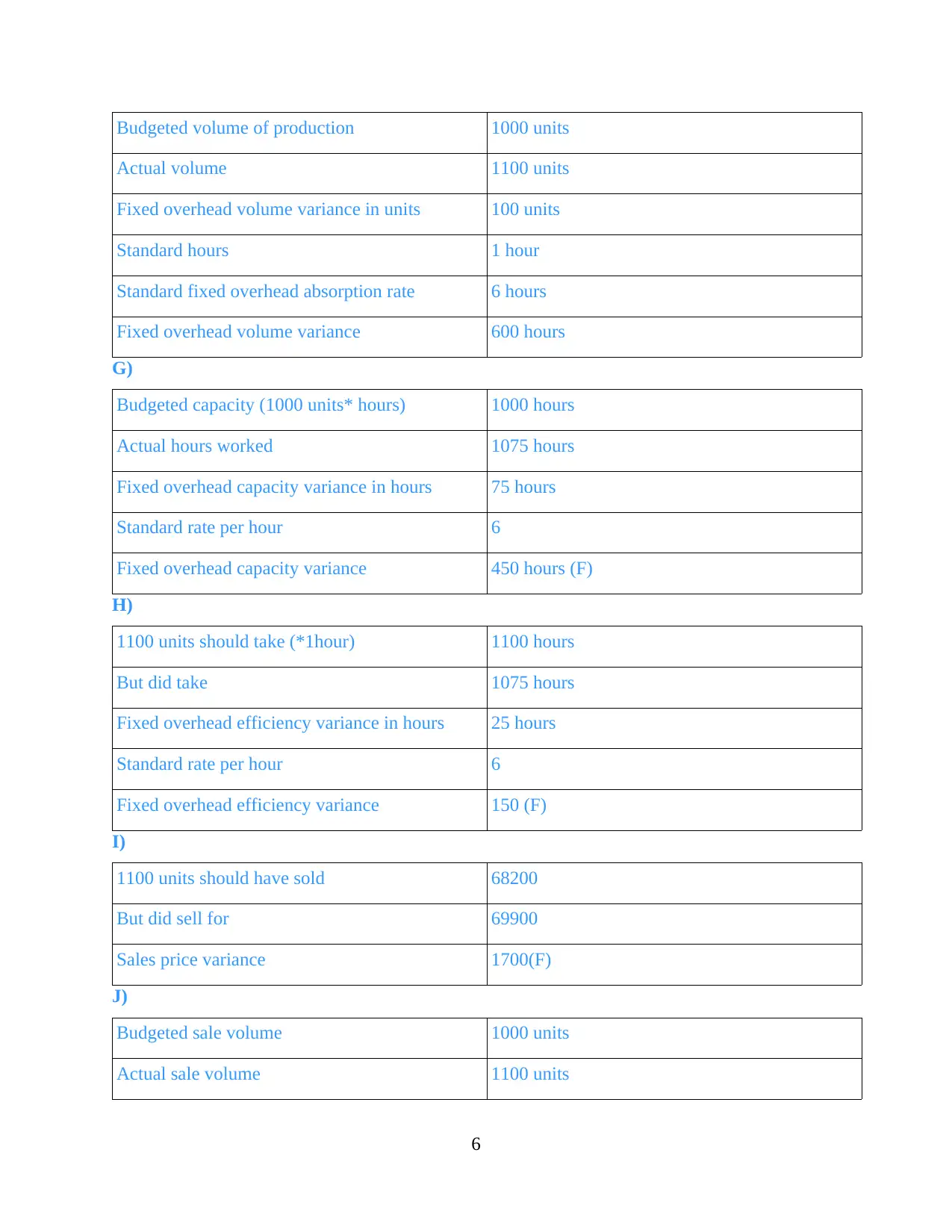
Budgeted volume of production 1000 units
Actual volume 1100 units
Fixed overhead volume variance in units 100 units
Standard hours 1 hour
Standard fixed overhead absorption rate 6 hours
Fixed overhead volume variance 600 hours
G)
Budgeted capacity (1000 units* hours) 1000 hours
Actual hours worked 1075 hours
Fixed overhead capacity variance in hours 75 hours
Standard rate per hour 6
Fixed overhead capacity variance 450 hours (F)
H)
1100 units should take (*1hour) 1100 hours
But did take 1075 hours
Fixed overhead efficiency variance in hours 25 hours
Standard rate per hour 6
Fixed overhead efficiency variance 150 (F)
I)
1100 units should have sold 68200
But did sell for 69900
Sales price variance 1700(F)
J)
Budgeted sale volume 1000 units
Actual sale volume 1100 units
6
Actual volume 1100 units
Fixed overhead volume variance in units 100 units
Standard hours 1 hour
Standard fixed overhead absorption rate 6 hours
Fixed overhead volume variance 600 hours
G)
Budgeted capacity (1000 units* hours) 1000 hours
Actual hours worked 1075 hours
Fixed overhead capacity variance in hours 75 hours
Standard rate per hour 6
Fixed overhead capacity variance 450 hours (F)
H)
1100 units should take (*1hour) 1100 hours
But did take 1075 hours
Fixed overhead efficiency variance in hours 25 hours
Standard rate per hour 6
Fixed overhead efficiency variance 150 (F)
I)
1100 units should have sold 68200
But did sell for 69900
Sales price variance 1700(F)
J)
Budgeted sale volume 1000 units
Actual sale volume 1100 units
6
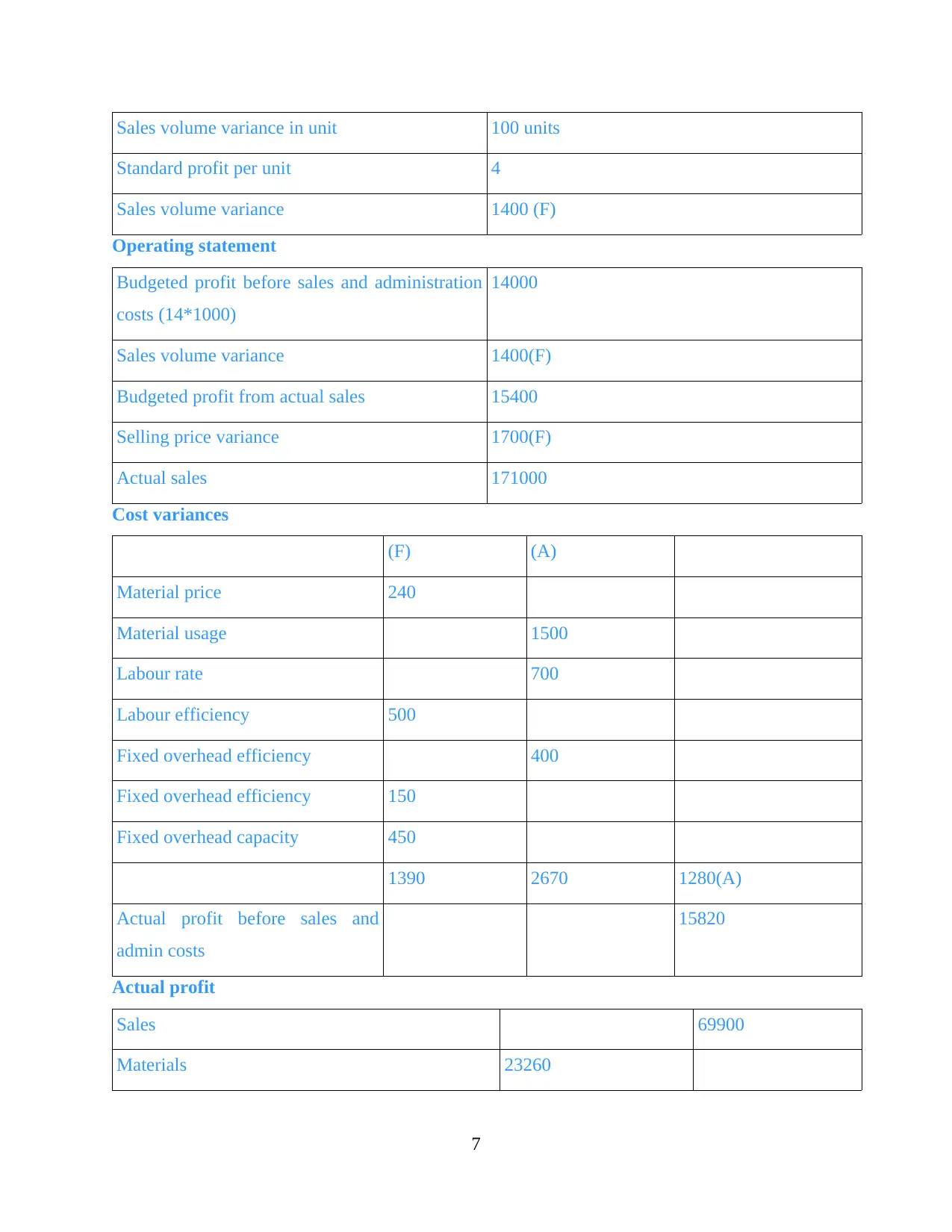
Sales volume variance in unit 100 units
Standard profit per unit 4
Sales volume variance 1400 (F)
Operating statement
Budgeted profit before sales and administration
costs (14*1000)
14000
Sales volume variance 1400(F)
Budgeted profit from actual sales 15400
Selling price variance 1700(F)
Actual sales 171000
Cost variances
(F) (A)
Material price 240
Material usage 1500
Labour rate 700
Labour efficiency 500
Fixed overhead efficiency 400
Fixed overhead efficiency 150
Fixed overhead capacity 450
1390 2670 1280(A)
Actual profit before sales and
admin costs
15820
Actual profit
Sales 69900
Materials 23260
7
Standard profit per unit 4
Sales volume variance 1400 (F)
Operating statement
Budgeted profit before sales and administration
costs (14*1000)
14000
Sales volume variance 1400(F)
Budgeted profit from actual sales 15400
Selling price variance 1700(F)
Actual sales 171000
Cost variances
(F) (A)
Material price 240
Material usage 1500
Labour rate 700
Labour efficiency 500
Fixed overhead efficiency 400
Fixed overhead efficiency 150
Fixed overhead capacity 450
1390 2670 1280(A)
Actual profit before sales and
admin costs
15820
Actual profit
Sales 69900
Materials 23260
7
⊘ This is a preview!⊘
Do you want full access?
Subscribe today to unlock all pages.

Trusted by 1+ million students worldwide
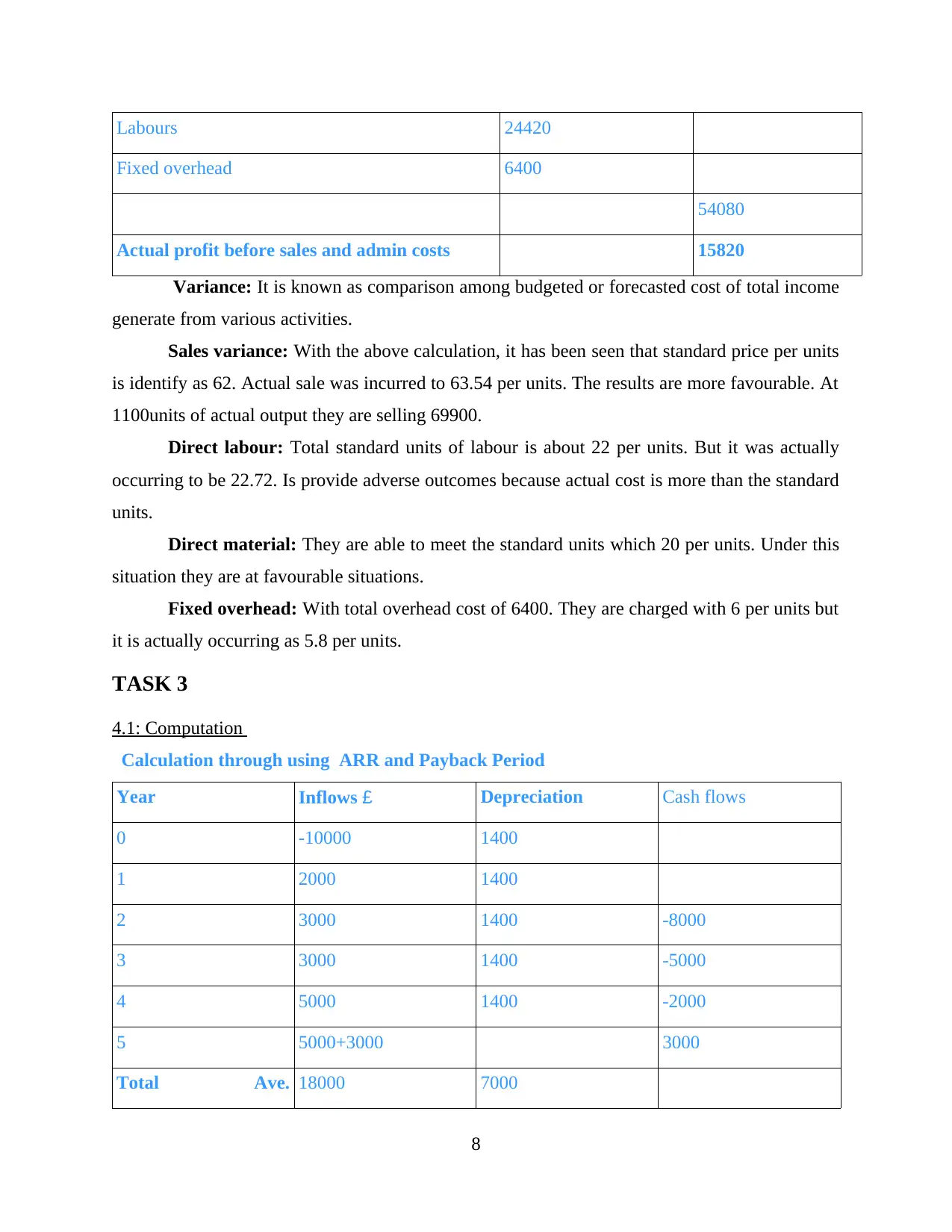
Labours 24420
Fixed overhead 6400
54080
Actual profit before sales and admin costs 15820
Variance: It is known as comparison among budgeted or forecasted cost of total income
generate from various activities.
Sales variance: With the above calculation, it has been seen that standard price per units
is identify as 62. Actual sale was incurred to 63.54 per units. The results are more favourable. At
1100units of actual output they are selling 69900.
Direct labour: Total standard units of labour is about 22 per units. But it was actually
occurring to be 22.72. Is provide adverse outcomes because actual cost is more than the standard
units.
Direct material: They are able to meet the standard units which 20 per units. Under this
situation they are at favourable situations.
Fixed overhead: With total overhead cost of 6400. They are charged with 6 per units but
it is actually occurring as 5.8 per units.
TASK 3
4.1: Computation
Calculation through using ARR and Payback Period
Year Inflows £ Depreciation Cash flows
0 -10000 1400
1 2000 1400
2 3000 1400 -8000
3 3000 1400 -5000
4 5000 1400 -2000
5 5000+3000 3000
Total Ave. 18000 7000
8
Fixed overhead 6400
54080
Actual profit before sales and admin costs 15820
Variance: It is known as comparison among budgeted or forecasted cost of total income
generate from various activities.
Sales variance: With the above calculation, it has been seen that standard price per units
is identify as 62. Actual sale was incurred to 63.54 per units. The results are more favourable. At
1100units of actual output they are selling 69900.
Direct labour: Total standard units of labour is about 22 per units. But it was actually
occurring to be 22.72. Is provide adverse outcomes because actual cost is more than the standard
units.
Direct material: They are able to meet the standard units which 20 per units. Under this
situation they are at favourable situations.
Fixed overhead: With total overhead cost of 6400. They are charged with 6 per units but
it is actually occurring as 5.8 per units.
TASK 3
4.1: Computation
Calculation through using ARR and Payback Period
Year Inflows £ Depreciation Cash flows
0 -10000 1400
1 2000 1400
2 3000 1400 -8000
3 3000 1400 -5000
4 5000 1400 -2000
5 5000+3000 3000
Total Ave. 18000 7000
8
Paraphrase This Document
Need a fresh take? Get an instant paraphrase of this document with our AI Paraphraser
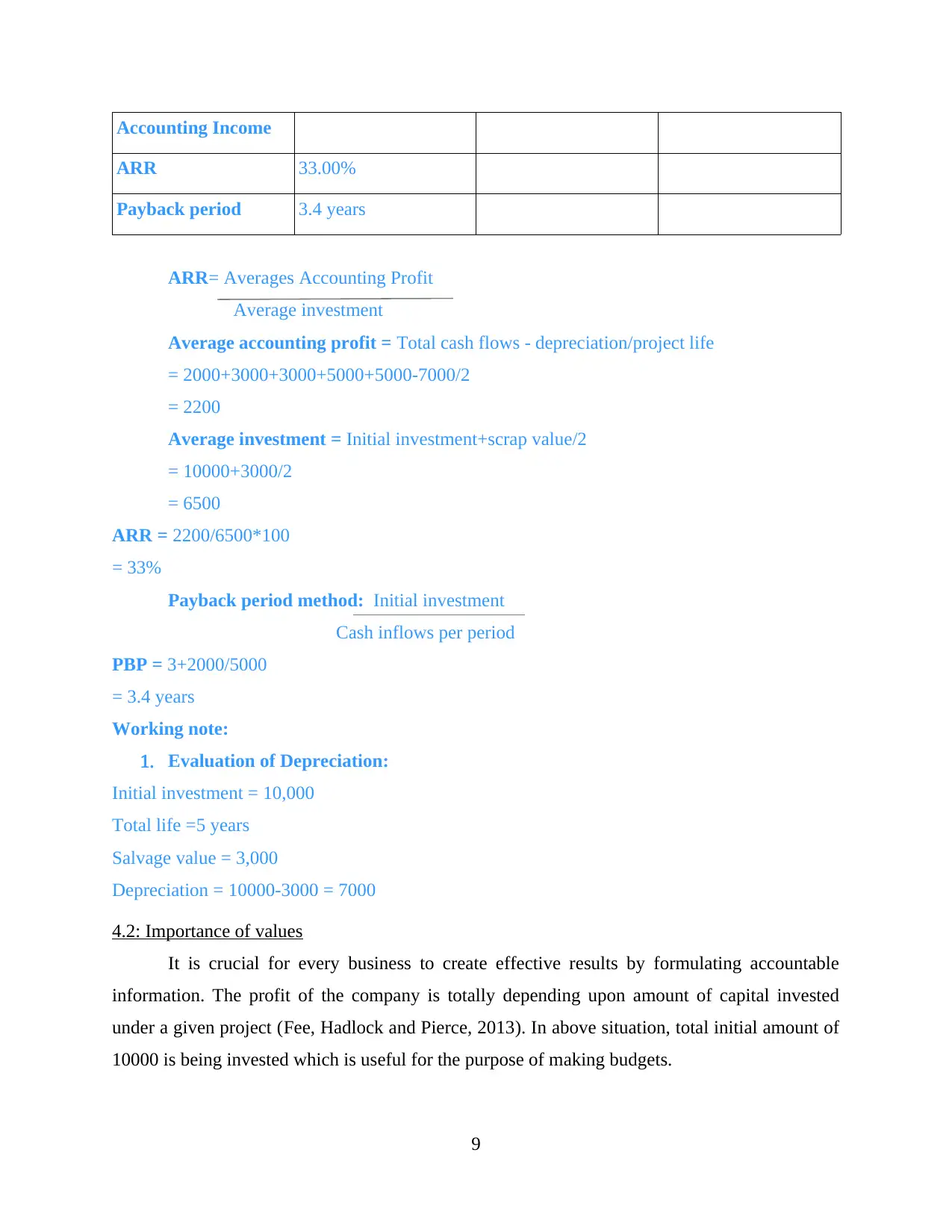
Accounting Income
ARR 33.00%
Payback period 3.4 years
ARR= Averages Accounting Profit
Average investment
Average accounting profit = Total cash flows - depreciation/project life
= 2000+3000+3000+5000+5000-7000/2
= 2200
Average investment = Initial investment+scrap value/2
= 10000+3000/2
= 6500
ARR = 2200/6500*100
= 33%
Payback period method: Initial investment
Cash inflows per period
PBP = 3+2000/5000
= 3.4 years
Working note:
1. Evaluation of Depreciation:
Initial investment = 10,000
Total life =5 years
Salvage value = 3,000
Depreciation = 10000-3000 = 7000
4.2: Importance of values
It is crucial for every business to create effective results by formulating accountable
information. The profit of the company is totally depending upon amount of capital invested
under a given project (Fee, Hadlock and Pierce, 2013). In above situation, total initial amount of
10000 is being invested which is useful for the purpose of making budgets.
9
ARR 33.00%
Payback period 3.4 years
ARR= Averages Accounting Profit
Average investment
Average accounting profit = Total cash flows - depreciation/project life
= 2000+3000+3000+5000+5000-7000/2
= 2200
Average investment = Initial investment+scrap value/2
= 10000+3000/2
= 6500
ARR = 2200/6500*100
= 33%
Payback period method: Initial investment
Cash inflows per period
PBP = 3+2000/5000
= 3.4 years
Working note:
1. Evaluation of Depreciation:
Initial investment = 10,000
Total life =5 years
Salvage value = 3,000
Depreciation = 10000-3000 = 7000
4.2: Importance of values
It is crucial for every business to create effective results by formulating accountable
information. The profit of the company is totally depending upon amount of capital invested
under a given project (Fee, Hadlock and Pierce, 2013). In above situation, total initial amount of
10000 is being invested which is useful for the purpose of making budgets.
9
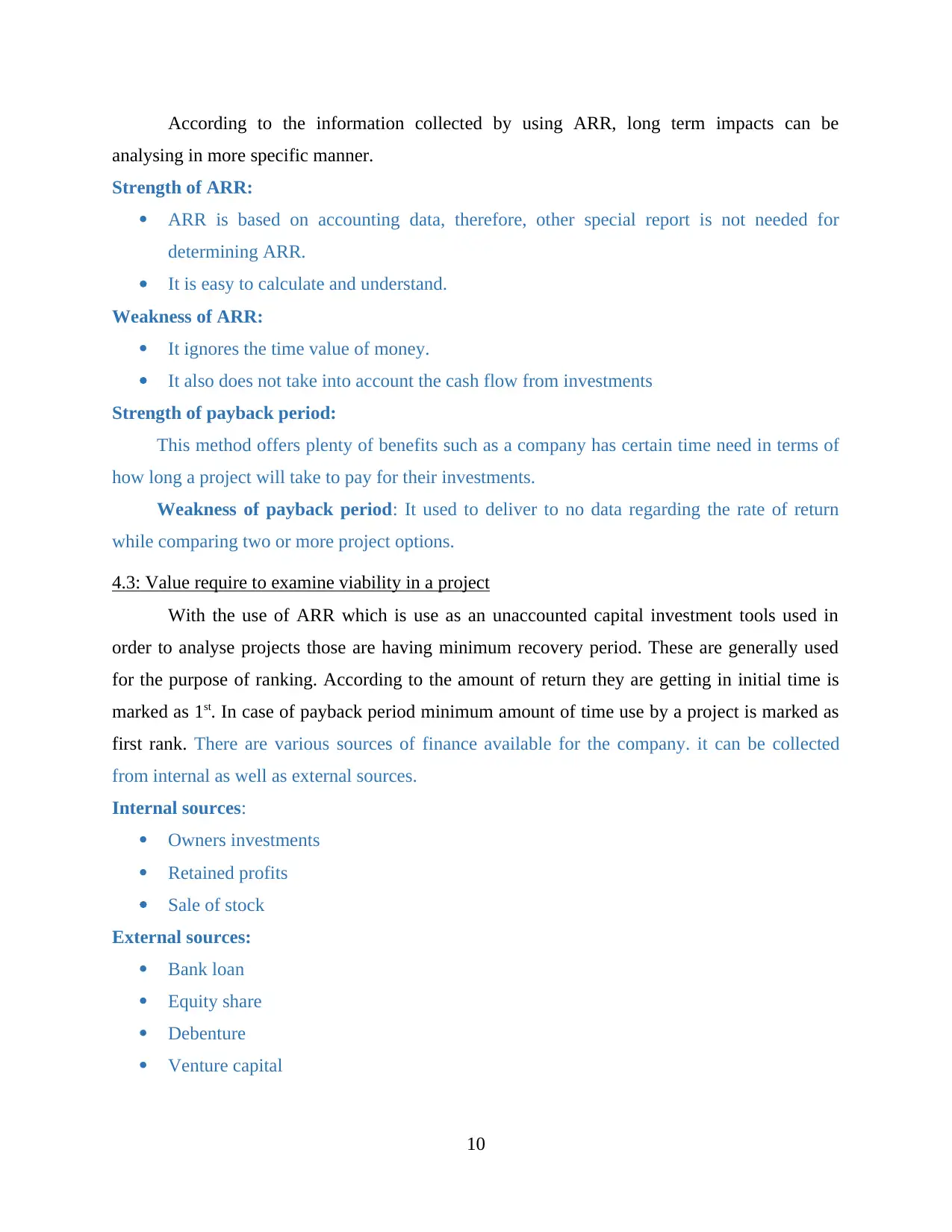
According to the information collected by using ARR, long term impacts can be
analysing in more specific manner.
Strength of ARR:
ARR is based on accounting data, therefore, other special report is not needed for
determining ARR.
It is easy to calculate and understand.
Weakness of ARR:
It ignores the time value of money.
It also does not take into account the cash flow from investments
Strength of payback period:
This method offers plenty of benefits such as a company has certain time need in terms of
how long a project will take to pay for their investments.
Weakness of payback period: It used to deliver to no data regarding the rate of return
while comparing two or more project options.
4.3: Value require to examine viability in a project
With the use of ARR which is use as an unaccounted capital investment tools used in
order to analyse projects those are having minimum recovery period. These are generally used
for the purpose of ranking. According to the amount of return they are getting in initial time is
marked as 1st. In case of payback period minimum amount of time use by a project is marked as
first rank. There are various sources of finance available for the company. it can be collected
from internal as well as external sources.
Internal sources:
Owners investments
Retained profits
Sale of stock
External sources:
Bank loan
Equity share
Debenture
Venture capital
10
analysing in more specific manner.
Strength of ARR:
ARR is based on accounting data, therefore, other special report is not needed for
determining ARR.
It is easy to calculate and understand.
Weakness of ARR:
It ignores the time value of money.
It also does not take into account the cash flow from investments
Strength of payback period:
This method offers plenty of benefits such as a company has certain time need in terms of
how long a project will take to pay for their investments.
Weakness of payback period: It used to deliver to no data regarding the rate of return
while comparing two or more project options.
4.3: Value require to examine viability in a project
With the use of ARR which is use as an unaccounted capital investment tools used in
order to analyse projects those are having minimum recovery period. These are generally used
for the purpose of ranking. According to the amount of return they are getting in initial time is
marked as 1st. In case of payback period minimum amount of time use by a project is marked as
first rank. There are various sources of finance available for the company. it can be collected
from internal as well as external sources.
Internal sources:
Owners investments
Retained profits
Sale of stock
External sources:
Bank loan
Equity share
Debenture
Venture capital
10
⊘ This is a preview!⊘
Do you want full access?
Subscribe today to unlock all pages.

Trusted by 1+ million students worldwide
1 out of 14
Related Documents
Your All-in-One AI-Powered Toolkit for Academic Success.
+13062052269
info@desklib.com
Available 24*7 on WhatsApp / Email
![[object Object]](/_next/static/media/star-bottom.7253800d.svg)
Unlock your academic potential
Copyright © 2020–2025 A2Z Services. All Rights Reserved. Developed and managed by ZUCOL.




